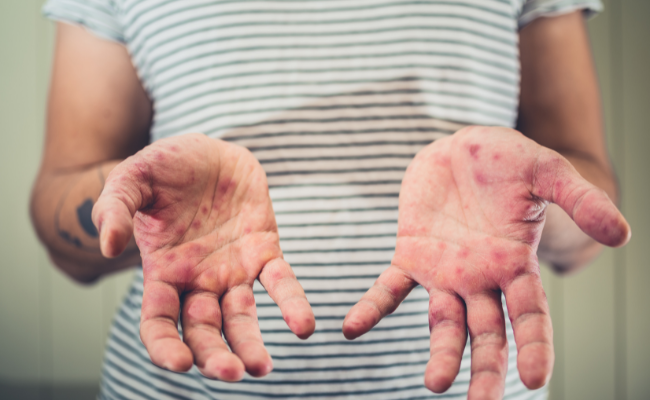How to Treat Hand And Foot And Mouth Disease?
- October 31, 2023
- No Comments

What is Hand, Foot, and Mouth Disease (HFMD)?
Hand, Foot, and Mouth Disease (HFMD) is a prevalent viral infection that commonly impacts infants and children, though it can also affect adults. Enteroviruses, primarily Coxsackievirus A16, are the main culprits behind HFMD. This highly contagious illness is characterized by the emergence of small, painful sores or blisters on the hands, feet, and inside the mouth.
Its occurrence is heightened in settings where individuals, particularly children, share close proximity, such as schools and daycare centers. While HFMD can manifest at any time throughout the year, it is more frequently reported during the summer and fall seasons. The disease derives its name from the blister-like rash that appears on a child's hands and feet, coupled with painful mouth sores. Remarkably, this rash can appear on various parts of the body, including the chest, back, arms, legs, genitals, and buttocks.
Why Does HFMD Occur?
HFMD is primarily transmitted through close personal contact with an infected person. The virus can also spread through contact with contaminated surfaces or objects. It is highly contagious, and environments where people are in close proximity, such as schools, daycare facilities, and playgrounds, provide optimal conditions for its transmission. Additionally, factors like poor hygiene practices and a lack of proper handwashing can contribute to the spread of HFMD. While anyone can contract the virus, young children, due to their developing immune systems, are particularly susceptible.
How to Treat HFMD?
Symptomatic Relief:
- Pain Relief Medications: Over-the-counter pain relievers like acetaminophen or ibuprofen are commonly recommended to alleviate discomfort and reduce fever associated with HFMD.
- Topical Creams: Applying creams or ointments with numbing agents can help soothe the pain caused by the sores.
Hydration and Nutrition:
- Fluid Intake: Ensuring adequate fluid intake is crucial to prevent dehydration, especially when oral intake may be challenging due to mouth sores.
- Soft Foods: Consuming soft, non-irritating foods can make eating more comfortable for individuals with HFMD.
Isolation and Hygiene:
- Isolation: Infected individuals should avoid close contact with others to prevent the further spread of the virus.
- Handwashing: Regular handwashing, especially after using the bathroom or changing diapers, is essential to reduce the risk of HFMD transmission.
Medical Monitoring:
- Fever Monitoring: Regularly checking the patient's temperature is crucial. If the fever persists or worsens, seeking medical attention is advisable.
Treatment Solutions for HFMD:
Antiviral Medications:
- Prescription Antivirals: In severe cases or for individuals with a weakened immune system, healthcare providers may prescribe antiviral medications to combat the viral infection more effectively.
Pain Management:
- Oral Pain Relief: Medications such as acetaminophen or ibuprofen can be administered to manage pain and reduce fever.
- Topical Treatments: Applying topical creams or ointments with analgesic properties directly to the sores can provide localized relief.
Hydration Support:
- Intravenous (IV) Fluids: In cases of severe dehydration, especially in young children, hospitalization may be necessary for intravenous fluid administration.
- Oral Rehydration Solutions: Encouraging the consumption of oral rehydration solutions helps maintain electrolyte balance and prevent dehydration.
Preventive Measures:
- Vaccination: While there is no specific vaccine for HFMD, staying up-to-date with routine vaccinations can prevent certain complications.
- Hygiene Practices: Emphasizing good hygiene, such as regular handwashing, remains a critical preventive measure to reduce the risk of HFMD transmission.
Benefit Points of Comprehensive HFMD Treatment:
- Quicker Recovery: Implementing a comprehensive treatment approach aids individuals in recovering more swiftly from HFMD symptoms.
- Reduced Discomfort: Symptomatic relief measures, including pain management and topical treatments, significantly reduce the discomfort associated with HFMD.
- Prevention of Complications: Timely medical monitoring and intervention can prevent or address complications, such as dehydration, especially in younger patients.
- Containment of Spread: Isolation measures and hygiene practices not only aid in the patient's recovery but also prevent the further spread of HFMD within communities.
- Support for Vulnerable Populations: Special attention and medical support are crucial for vulnerable populations, such as infants and individuals with weakened immune systems, ensuring their well-being during and after HFMD.
Comments (0)